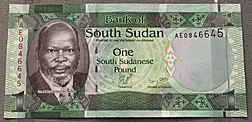The Kwacha is the currency of Zambia. It is subdivided into 100 Ngwee.

The kwacha is the currency of Malawi as of 1971, replacing the Malawian pound. It is divided into 100 tambala. The kwacha replaced other types of currency, namely the British pound sterling, the South African rand, and the Rhodesian dollar, that had previously circulated through the Malawian economy. The exchange rate of the kwacha undergoes fixed periodical adjustments, but since 1994 the exchange rate has floated. In 2005, administrative measures were put in place by Bingu wa Mutharika to peg the exchange rate with other currencies. Banknotes are issued by the Reserve Bank of Malawi. In May 2012, the Reserve Bank of Malawi devalued the kwacha by 34% and unpegged it from the United States dollar. The currency was further devalued by 25% by the central bank in May 2022 followed by another 44% devaluation in November 2023 raising inflation rate in Malawi.
The South African rand, or simply the rand, is the official currency of the Southern African Common Monetary Area: South Africa, Namibia, Lesotho and Eswatini. It is subdivided into 100 cents, and a comma separates the rand and cents.

The Namibia dollar has been the currency of Namibia since 1993. It is normally abbreviated with the dollar sign ($), or alternatively N$ to distinguish it from other currencies called “dollar.” It is divided into 100 cents.

The Singapore dollar is the official currency of the Republic of Singapore. It is divided into 100 cents. It is normally abbreviated with the dollar sign $, or S$ to distinguish it from other dollar-denominated currencies. The Monetary Authority of Singapore (MAS) issues the banknotes and coins of the Singapore dollar.

The pula is the currency of Botswana. It has the ISO 4217 code BWP and is subdivided into 100 thebe. Pula literally means "rain" in Setswana, because rain is very scarce in Botswana—home to much of the Kalahari Desert—and therefore valuable and a blessing. The word also serves as the national motto of the country.

The lilangeni is the currency of Eswatini and is subdivided into 100 cents. It is issued by the Central Bank of Eswatini and is authorised by the king and his family. The South African rand is also accepted in Eswatini. Similar to the Lesotho loti, there are singular and plural abbreviations, namely L and E, so where one might have an amount L1, it would be E2, E3, or E4.
The leone is the currency of Sierra Leone. It is subdivided into 100 cents. As of 1 July 2022, the ISO 4217 code is SLE due to a redenomination of the old leone (SLL) at a rate of SLL 1000 to SLE 1. The leone is abbreviated as Le placed before the amount.
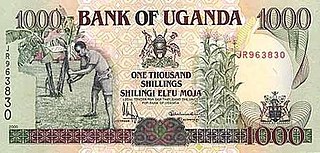
The shilling is the currency of Uganda. Officially divided into cents until 2013, due to substantial inflation the shilling now has no subdivision.

The shilling is the currency of Tanzania. It is subdivided into 100 cents . The Tanzanian shilling replaced the East African shilling on 14 June 1966 at par.

The Fijian dollar has been the currency of Fiji since 1969 and was also the currency between 1867 and 1873. It is normally abbreviated with the dollar sign $, or alternatively FJ$ to distinguish it from other dollar-denominated currencies. It is divided into 100 cents.

The Jamaican dollar has been the currency of Jamaica since 1969. It is often abbreviated to J$, the J serving to distinguish it from other dollar-denominated currencies. It is divided into 100 cents, although cent denominations are no longer in use as of 2018. Goods and services may still be priced in cents, but cash transactions are now rounded to the nearest dollar.
The dinar was the currency of Sudan between 1992 and 2007. Its ISO 4217 code was "SDD" and had no official subdivision. It replaced the first Sudanese pound and, in turn, was replaced by the second Sudanese pound.

The Guyanese dollar has been the unit of account in Guyana since 29 January 1839. Originally it was intended as a transitional unit to facilitate the changeover from the Dutch guilder system of currency to the British pound sterling system. The Spanish dollar was already prevalent throughout the West Indies in general, and from 1839, the Spanish dollar unit operated in British Guiana in conjunction with British sterling coins at a standard conversion rate of one dollar for every four shillings and twopence. In 1951 the British sterling coinage was replaced with a new decimal coinage which was simultaneously introduced through all the British territories in the Eastern Caribbean. When sterling began to depreciate in the early 1970s, a switch to a US dollar peg became increasingly attractive as an anti-inflationary measure and the Eastern Caribbean Currency Authority made the switch in October 1975. The Guyanese dollar is normally abbreviated with the dollar sign $, or alternatively G$ to distinguish it from other dollar-denominated currencies.

The ruble, rouble or rubel is the currency of Belarus. It is subdivided into 100 kopecks.
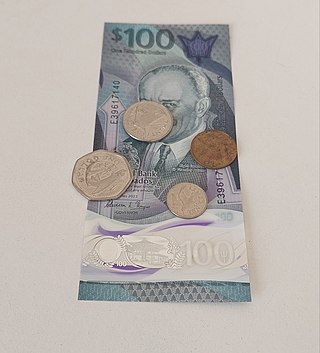
The dollar has been the currency of Barbados since 1935. Globally its currency has the ISO 4217 code BBD, however, unofficially in Barbados the International vehicle registration code BDS is also commonly used, a currency code that is otherwise reserved for Bangladesh outside Barbados. As such the present Barbados dollar has the official ISO 4217 code of BB which matches the [dot] .bb Cc-TLD domain names classification for Barbados under ISO 3166, plus D for dollar in the foreign exchange market. The Barbadian dollar is considered as a currency which can be divided into 100 cents, though the 1 cent coin is in the process of being phased out. In terms of population, Barbados is the third smallest country in the world after Tonga and the Seychelles to have an independent currency and monetary policy.
The tālā is the currency of Samoa. It is divided into 100 sene. The terms tālā and sene are the equivalents of the English words dollar and cent in the Samoan language. Its symbol is $, or WS$ to distinguish it from other currencies named dollar.
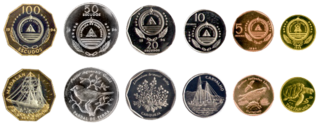
The escudo is the currency of the Republic of Cape Verde. One escudo is subdivided into one hundred centavos.
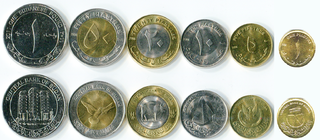
The Sudanese pound is the currency of the Republic of the Sudan. The pound is divided into 100 piastres. It is issued by the Central Bank of Sudan.

The Kiribati dollar is one of the two official currencies of Kiribati. The Kiribati coins are pegged at 1:1 ratio to the Australian dollar, the other official currency of Kiribati. Kiribati coins were issued in 1979 and circulate alongside banknotes and coins of the Australian dollar. In present day, Kiribati coins are rare in comparison to Australian coins with the last minor emission made in 1992, and these old coins are now generally collectors items. The complete emissions of coins were made in 1979 and in 1989 for the tenth anniversary of independence.
